Served with a red wine reduction sauce, this Japanese Hamburger Steak (Hambagu) is big on flavors. The meat is juicy and melts in your mouth. It‘s perfect to make in a hot frying pan either in the kitchen or on the grill!
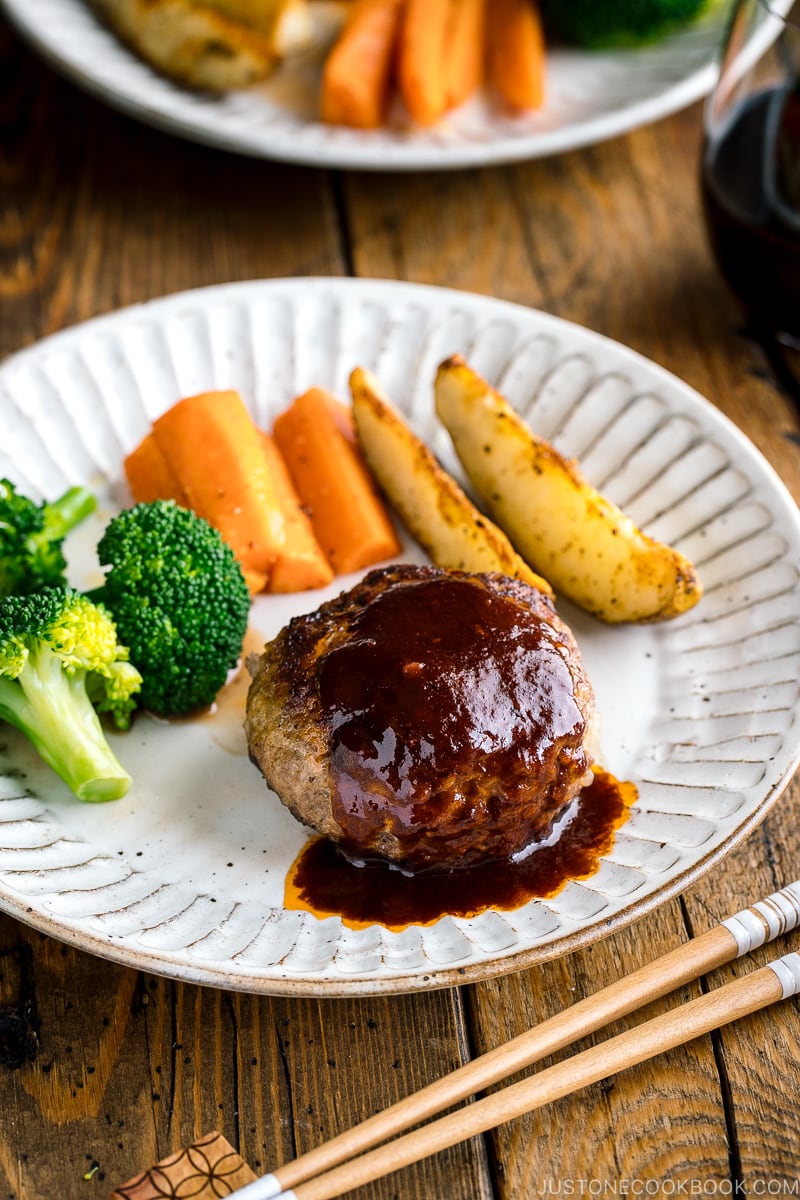
I still remember vividly how my mom and I spent many evenings making Japanese Hamburger Steak or Hambagu (ハンバーグ). If I was home, she would call me around 4:30 PM and always encouraged my presence in the kitchen. Unless I was in the middle of a novel that I couldn’t stop reading, I didn’t mind helping her out most of the time. That’s how I learned to cook Japanese food from her.
What is Hambagu
Japanese Hamburger Steak, or we call it Hambāgu (ハンバーグ) or Hambāgu Steak (ハンバーグステーキ), is a popular dish enjoyed both at home and at Yoshoku (Japanese style western food) restaurants. It’s a steak made from ground meat and usually served with rice rather than buns.
While researching facts about Hambāgu on Japanese Wiki, I learned that there is an American version of hamburger steak and it’s very similar to a dish called Salisbury Steak, which I’ve never tried before.
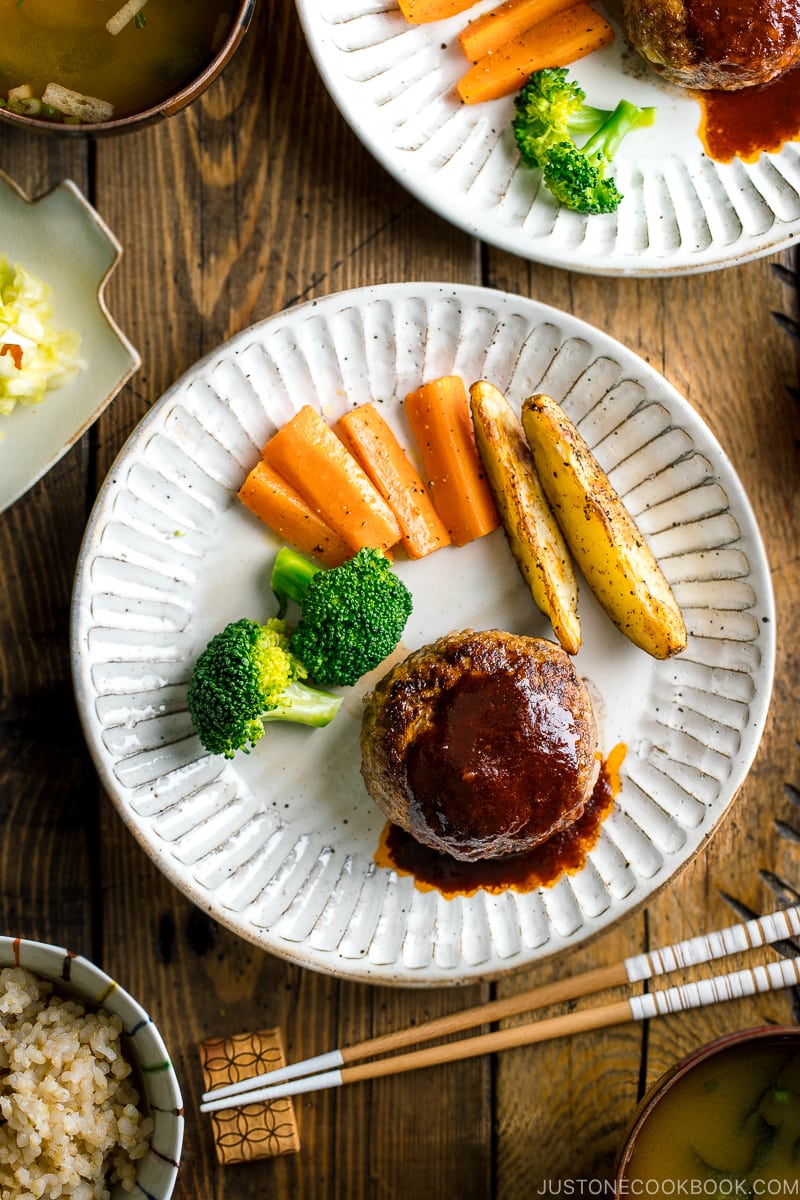
Variations of Japanese Hamburger Steak
The common theme for all these hamburger steaks is that they are made from a blend of minced beef and other ingredients.
There are many variations of Hambāgu in Japan, like Wafu Hambāgu (soy sauce-based sauce with grated daikon), Teriyaki Hambāgu, Demi-glacé Hambāgu, and more. You’ll also find different topping options, such as sautéed shimeji mushrooms and a fried egg.
Today I’m sharing the basic Hambāgu recipe with a delicious homemade sauce.
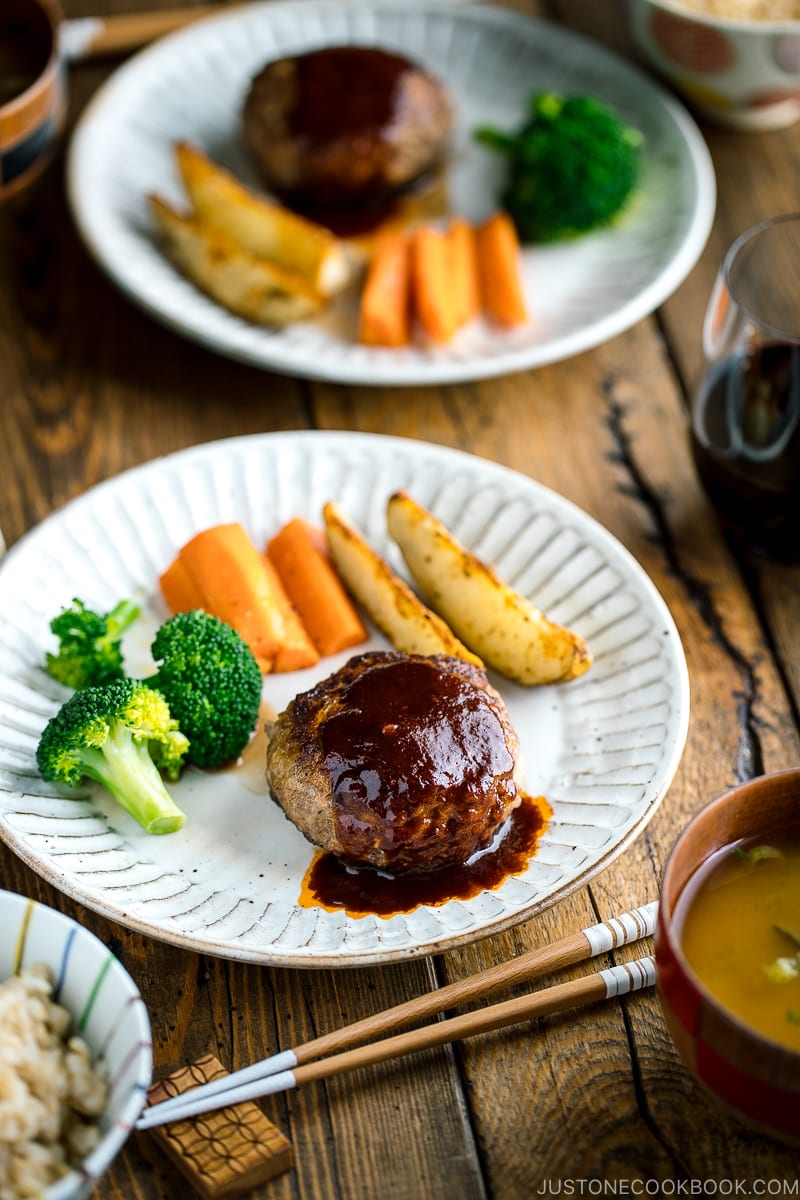
Use of Both Ground Beef and Ground Pork
Hambāgu in Japan is typically made from both ground beef and ground pork. Supermarkets in Japan sell a convenient package of both ground beef and ground pork (we call it Aibiki Niku 合いびき肉) so that we don’t have to buy the meat separately. The common ratio of Aibiki Niku is 7:3.
For this Hambagu recipe, you can decide the beef/pork ratio either 2:1 (8 oz/4 oz) or 3:1 (9 oz/3 oz).
We often use this Aibiki Niku for Menchi Katsu, Spaghetti Meat Sauce, Curry Doria (Rice Gratin), and Hambāgu recipes.
7 Tips to Make Perfect Hamburger Steak
To enhance the flavor of Hambāgu, below are a few important tips, which I learned from my mom. I also included a video on how to toss hamburger steak to force out the air pockets.
- Sauté onion slowly and then cool it down completely. The cooked onion will add natural sweetness to Hambāgu.
- Knead the mixture with your hand until it’s pale and sticky.
- Play catch, tossing meat mixture from your left hand to your right hand. Do this a couple of times in order to release the air inside. If you skip it, the hambagu will crack while cooking.
- Let the meat patties cool in the refrigerator for 20-30 minutes to solidify fats and take them out right before cooking.
- Indent the center of each patty with 2-3 fingertips to avoid explosion or crumbling of the meat patties when you cook. The meat will expand during cooking, and the indentation will disappear.
- Use wine for steam cooking and the delicious sauce. If you can’t consume alcohol, use beef/chicken stock instead.
- Cook the red wine reduction sauce in the same pan. The rich grease left in the pan adds another layer of flavor to the already juicy Hambāgu.

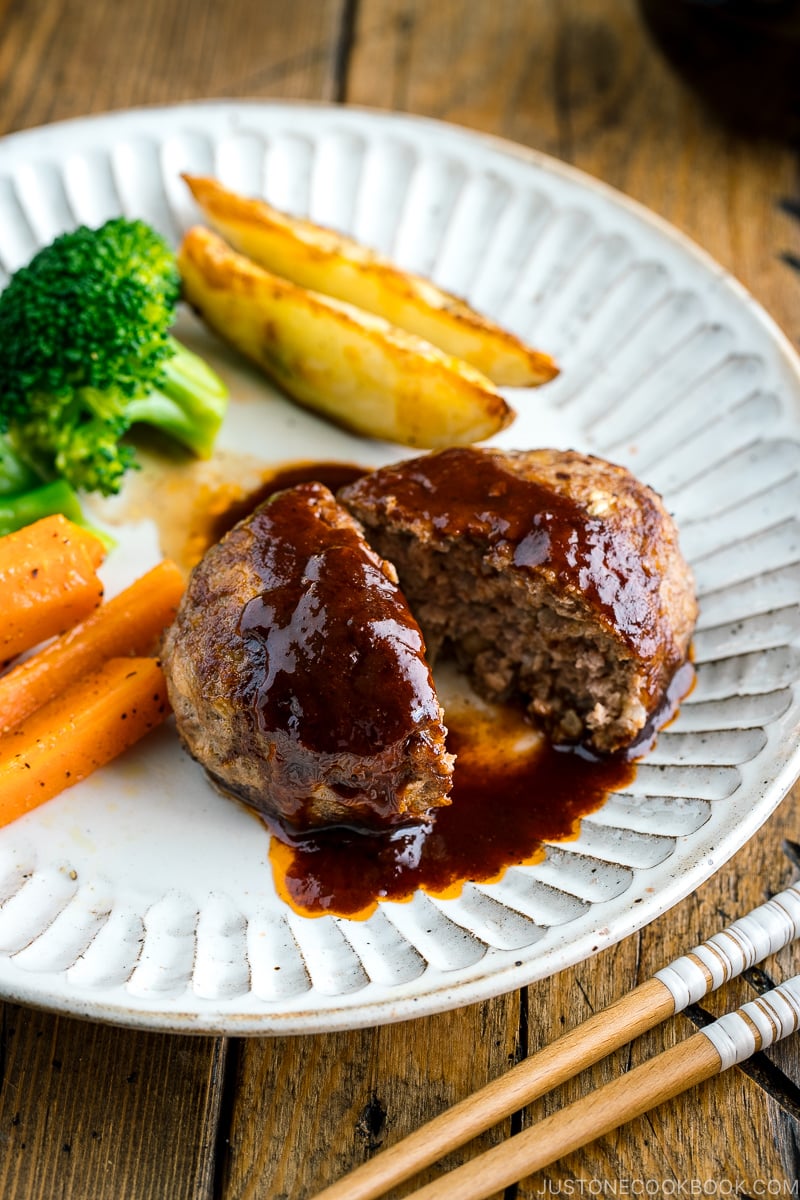
How to Serve with Hambagu
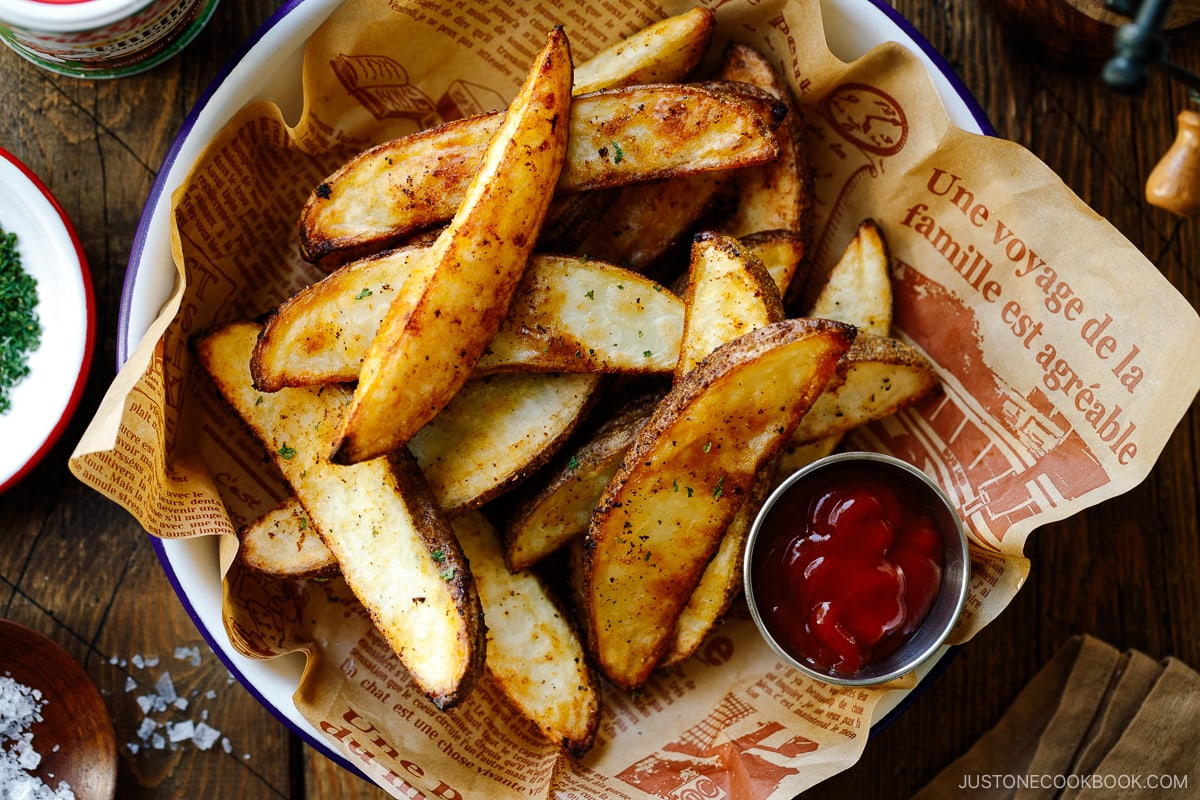
Serve the Hamburger Steak with Crispy Baked Potato Wedges, steamed broccoli, and sauteed carrots. If you want to make it into a Japanese-style meal, serve this dish with steamed rice and Miso Soup. You will have a fancy and extra special dinner that doesn’t cost a bomb. This is exactly the kind of recipe that calls for a bottle of red wine and a reason to celebrate.
Other Japanese Hamburger Recipes You’ll Enjoy
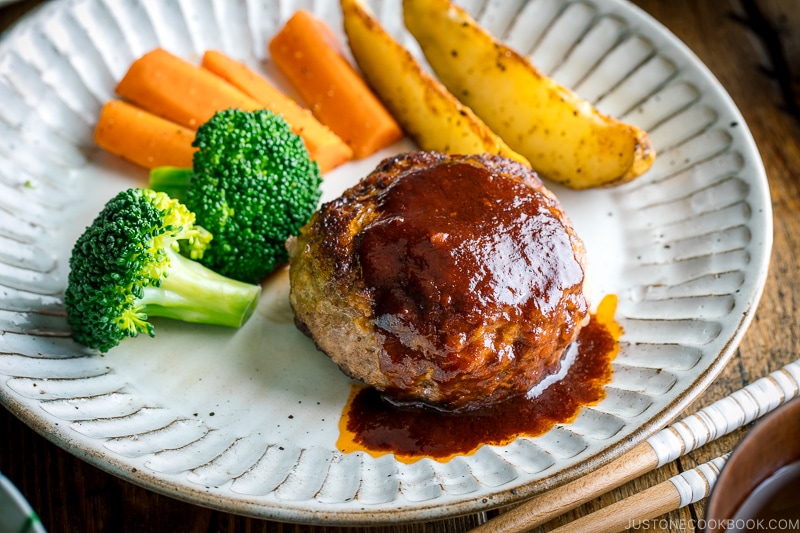
Wish to learn more about Japanese cooking? Sign up for our free newsletter to receive cooking tips & recipe updates! And stay in touch with me on Facebook, Pinterest, YouTube, and Instagram.
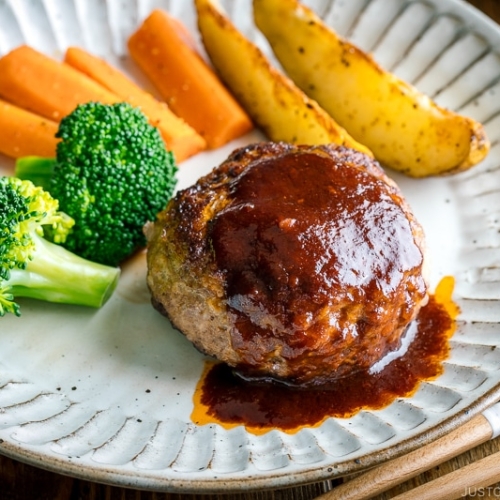
Japanese Hamburger Steak (Hambagu)
Video
Ingredients
For the Hambagu Patties
- ½ onion (5 oz, 142 g)
- 1 Tbsp neutral oil
- ¾ lb ground beef and pork combination (2 to 1 (8 oz/4 oz) or 3 to 1 (9 oz/3 oz) is a good beef-to-pork ratio)
- ½ tsp Diamond Crystal kosher salt
- freshly ground black pepper
- ½ tsp nutmeg
- ⅓ cup panko (Japanese breadcrumbs)
- 2 Tbsp milk
- 1 large egg (50 g each w/o shell)
For Cooking the Hambagu
- 1 Tbsp neutral oil
- 3 Tbsp red wine (for steaming; I use this mini wine; or substitute beef or chicken stock)
For the Sauce
- 1 Tbsp unsalted butter
- 3 Tbsp ketchup (to taste)
- 3 Tbsp tonkatsu sauce (or make Homemade Tonkatsu Sauce)
- 3 Tbsp red wine (I use this mini wine; or substitute beef or chicken stock)
- 3 Tbsp water
Instructions
Before You Start…
- Please note that this recipe requires 30 minutes of inactive resting time (patties in the refrigerator) in addition to the total active cooking time.
- Gather all the ingredients. If doubling the recipe, please cook one batch at a time in the pan.

To Make the Hambagu Patties
- Mince ½ onion finely (we call this cutting technique mijingiri in Japanese). Lay the cut onion flat side down on the cutting board. With the knife tip pointing toward the root end, make ⅛-inch vertical slices to within ½ inch of the root end. With the knife edge toward the root end, make ⅛-inch horizontal slices, again keeping the root intact.

- Finally, make perpendicular cuts down through the vertical slices you made. If you need to chop the onions finer, run your knife through them using a rocking motion. Hold down the tip of the knife; otherwise, the onions will go flying around the room.

- Heat a large pan over medium heat. When the pan is hot, add 1 Tbsp neutral oil. Then, add the onions.

- Sauté the onions until tender and almost translucent. Transfer to a large bowl and let it cool.

- Once the onions are cool, add ¾ lb ground beef and pork combination to the bowl. Add ½ tsp Diamond Crystal kosher salt, freshly ground black pepper as you like, and ½ tsp nutmeg. Tip: You can make hambagu with 100% beef, but it will not be as juicy and tender as combining the two meats.

- Add the ⅓ cup panko (Japanese breadcrumbs), 2 Tbsp milk, and 1 large egg (50 g each w/o shell).

- Start mixing it all together with a silicone spatula or spoon.

- Then, switch to mixing by hand and knead the mixture until it‘s sticky and pale.

- Divide the mixture into 4 portions (4 oz, 113 g each) or 6 smaller portions. Scoop out one portion.

- Toss it from one hand to the other repeatedly about five times in order to release any air inside the mixture (see the video link above). Tip: Without releasing the air inside, the hamburger steaks will likely crack while cooking.

- Make an oval-shaped patty and place on a tray or plate. Repeat with the remaining portions. Cover the patties with plastic wrap and keep them in the refrigerator for at least 30 minutes before cooking so that the meat combines well and the fat solidifies.

To Cook the Hambagu
- Heat a large pan over medium heat. (Cook one batch at a time if you‘re doubling the recipe.) When the pan is hot, add 1 Tbsp neutral oil. Place the patties gently into the pan. Indent the center of each patty with two fingers because the centers will rise with the heat.

- Cook the patties until browned on the bottom side, about 3 minutes. Then, carefully flip and cook for another 3 minutes until browned.

- Add 3 Tbsp red wine and reduce the heat to low. Cover the pan with a lid and cook for 5–7 minutes to thoroughly cook the inside of the patties (adjust the cooking time depending on the thickness of the patties).

- Uncover and check that it‘s fully cooked by inserting a skewer; if clear juice comes out, it‘s done. Increase the heat to medium to let the alcohol finish evaporating. When it’s almost finished, transfer the hamburger steaks to individual plates. Do not wash the pan as you will make the sauce next using the pan juices.

To Make the Red Wine Reduction Sauce
- To the same frying pan, add the ingredients for the sauce (for one batch): 1 Tbsp unsalted butter, 3 Tbsp ketchup, and 3 Tbsp tonkatsu sauce. Tip: Since some ketchup is sweeter than others, adjust the amount to taste. For the tonkatsu sauce, you can substitute Worcestershire sauce and sugar in a pinch.

- Add 3 Tbsp red wine and 3 Tbsp water to the pan.

- Mix well together and bring the sauce to a simmer over medium heat; let the alcohol evaporate.

- When the sauce thickens (and you can draw a line on the bottom of the frying pan with a spatula), remove from the heat. Drizzle some sauce over the hamburger steaks.

To Serve
- Pour the remaining sauce into a small bowl or jar and bring it to the table for serving. We typically serve Steamed Rice, Homemade Miso Soup, Crispy Baked Potato Wedges, sauteed carrots, and steamed broccoli or a salad with this meal. Hambagu also goes well with Japanese Potato Salad and Corn Potage (Japanese Corn Soup).
To Store
- Transfer the leftover hamburger steaks to an airtight container and let them cool completely. You can store them in the refrigerator for up to 3 days and the freezer for up to a month.
Nutrition
Editor’s Note: The post was originally published on December 17, 2012. The content has been updated in August 2017. The post has been updated with a new video and images in June 2020.
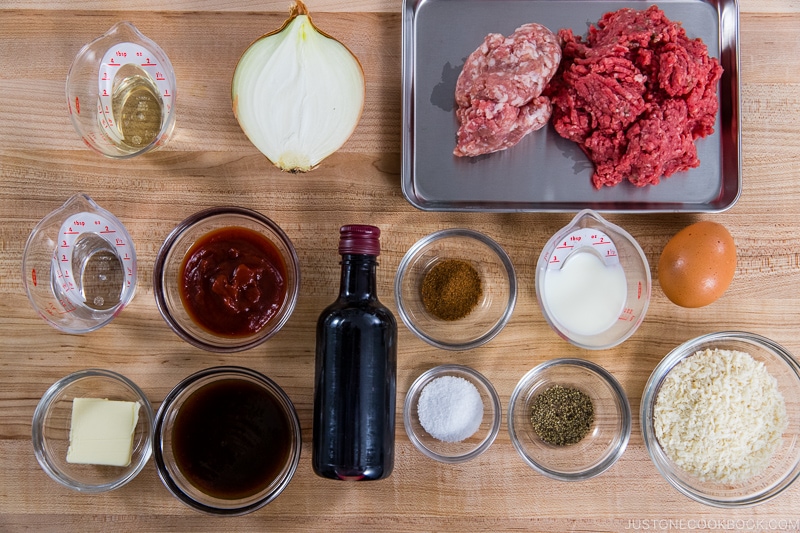
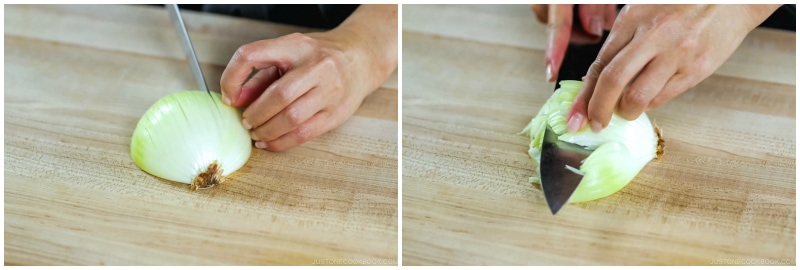
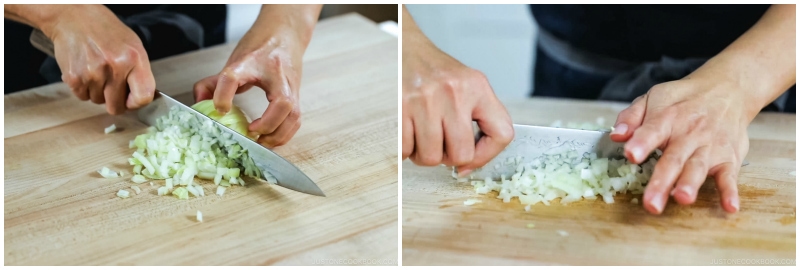
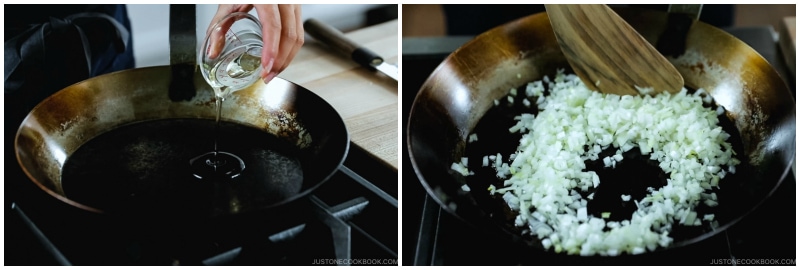
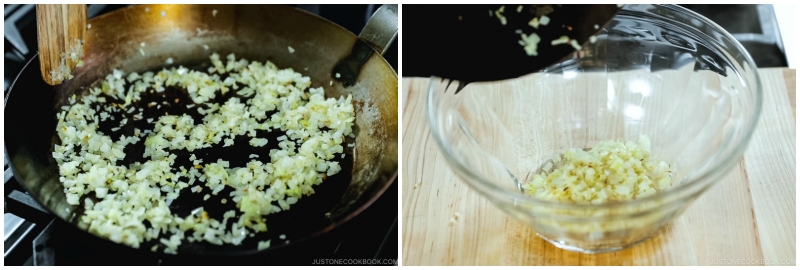

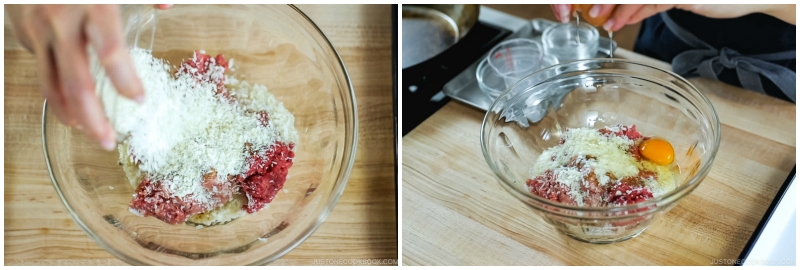
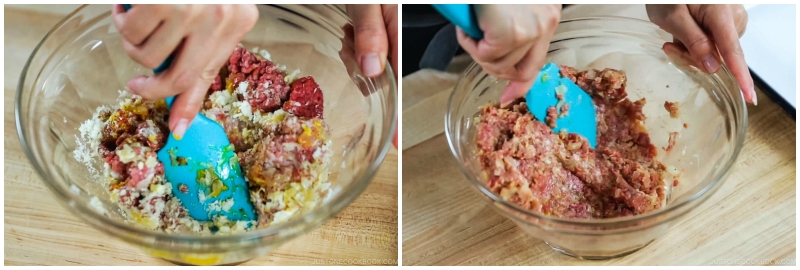

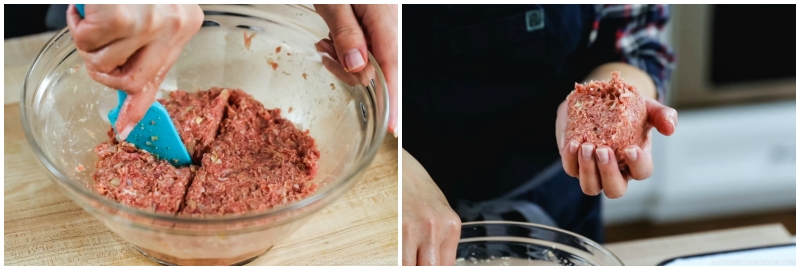

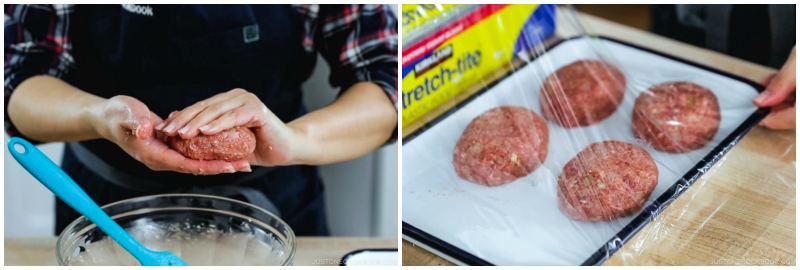
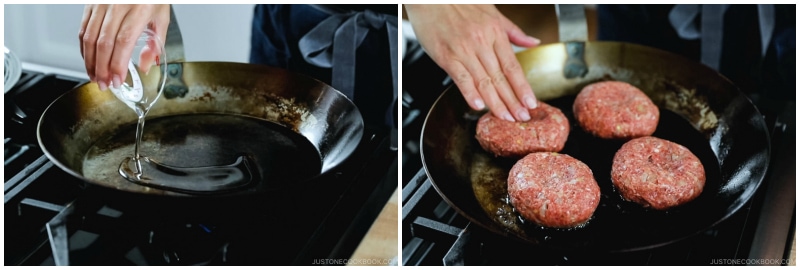
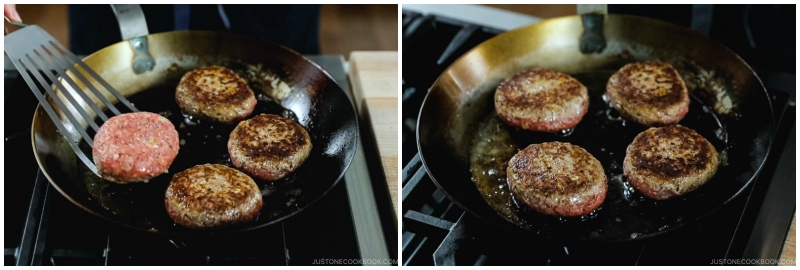
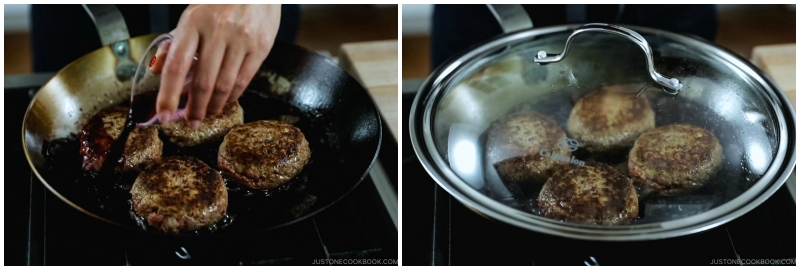
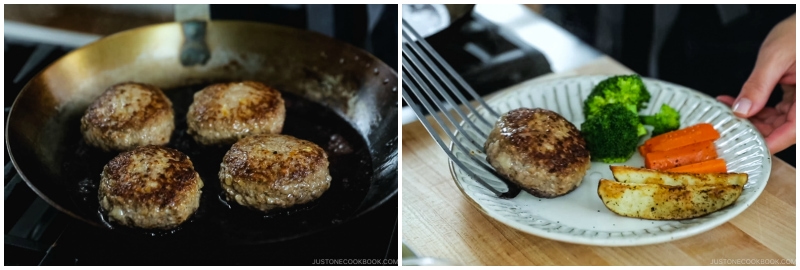
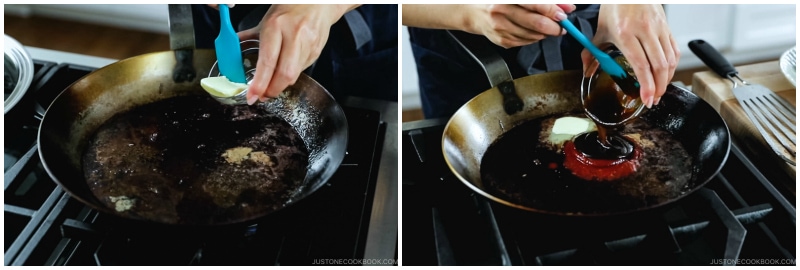
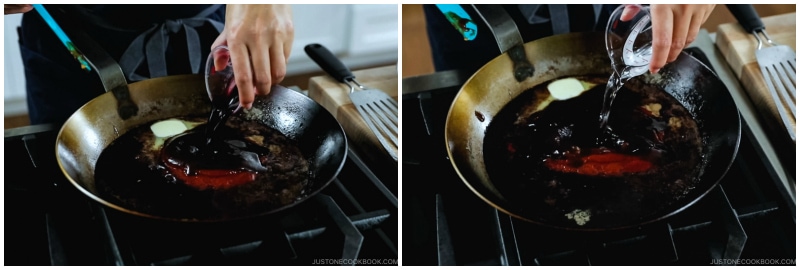
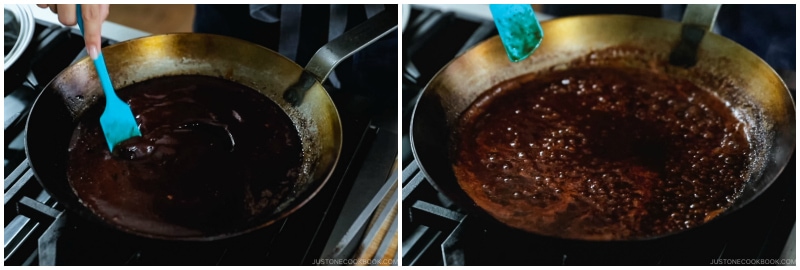



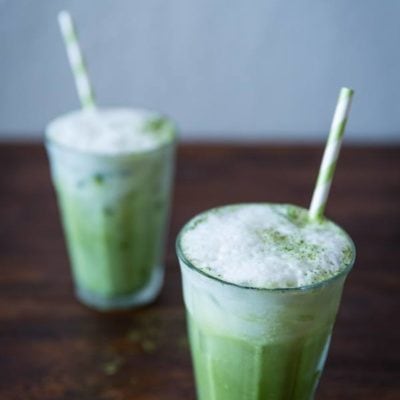

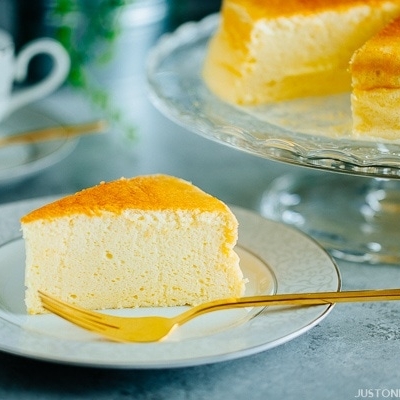


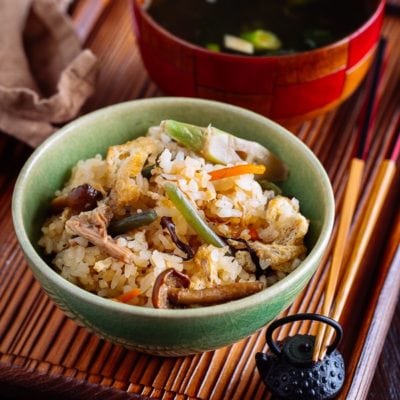
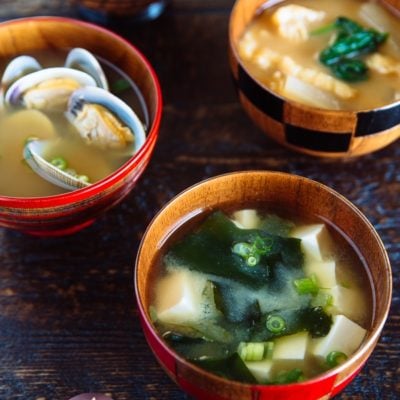


Hi Namiko,
I have tried two versions of your ground mince steak i.e. Hambagu, Wafu Hambagu and Menchikatsu. I love them all.
Couple of questions:
1) Why is it necessary to fry the onions? Is that a personal preference?
2) What can we do with leftover cooked Hambagu?
Thanks again and I love all the recipes that you have on JOC! I travelled to Japan just before COVID hit (Jan 2020) and I loved every minute that I was there.
Since then, I’ve been trying out various recipes on JOC!
Hi Marie! Thank you very much for trying Nami’s recipe!
Here are answers to your questions!
1) The cooked onion will add natural sweetness to Hambagu, and it makes the Hambagu texture softer.
2) Nami usually freezes the leftover in an airtight glass container for individual use, so it can microwave as needed, and she uses them for kids’ lunch boxes. You can also make sandwiches etc. https://www.justonecookbook.com/spectacular-japanese-sandwiches-to-make/
We hope this helps!
Made this for our lockdown anniversary dinner and the taste brought my husband and I back to Japan! It’s hard to find a decent ハンバーグ near us and we’re so glad this recipe is so spot on in its flavours and texture.
Hi Rin! Thank you very much for trying Nami’s recipe!
We couldn’t be happier to hear how much joy and excitement Nami’s recipe has brought to you! ☺️
Insanely tasty!! Love all the elements that go into the flavor of the sauce and the meat patty. I was also worried about the meat being dry, but no, it was cooked perfectly! Would definitely make this again.
Hi Katie! Thank you very much for trying Nami’s recipe and for your kind feedback!
We are glad to hear you enjoyed Hambagu!☺️
This is a wonderful recipe and very flavourful! I was quite surprised that if you follow substitutions for the sauce, it tastes very much like Brown sauce, or HP sauce in the uk. I would hazard that if you didnt have ketchup or Worcestershire sauce, brown sauce would be the next best thing.
Hi Leigh! We are glad to hear you enjoy the flavor of this Hambagu!
Thank you very much for trying Nami’s recipe and for sharing your cooking experience with us!
My daughter has an egg allergy what could I use as a substitute?
Hi Sascha, Thank you for trying Nami’s recipe!
You can substitute egg with double the amount of panko and milk or 50g (about 3 Tbps) of silken Tofu.
You can also try this recipe without an egg if it works better for you. Please make sure to knead the mixture until sticky and pale.
We hope this is helpful.
This looks so good that I will have it for my dinner or lunch tomorrow. Already have something else started for today or I would do it now.
thank you! I love my Bulldog sauce.
Hi Barbara! Thank you very much for your kind feedback!
We hope you enjoy this delicious homemade Hambagu.
Hi Namikoさん! ♡ I made this for my boyfriend (who is Japanese) recently and he said it tasted just like his mom made it! It was so fun to make, and you made the recipe very easy to follow. Thank you for your that!
I am wondering though, are the nutrition facts provided just for one Hamburg patty? Could you please confirm? Thank you so much! I look forward to making more recipes from JOC! ╰(*´︶`*)╯♡
Hi Monica! Thank you very much for trying Namiko’s recipe and for your kind feedback!
We are so happy to hear you and your boyfriend enjoyed homemade Hambagu.
The nutrition information is for approximately one serving/one patty and includes some sauce.
We hope this helps!
Hi Nami, I tried this and it was amazing! I want to make it again but I was wondering what should with the grease I do if my fry pan is too small to fry all of the patties and need to be used multiple times. Would I pour the grease into a bowl and add it back to the pan once I’m ready to make the sauce?
Hi Ally, Thank you very much for trying Nami’s recipe and for your kind feedback!
We think it’s best to save the grease into a bowl, as you mentioned, or use two pans for cooking the patties. Happy Cooking!
Loved it. Really easy to make. To be the substitute person, I used 100% venison ground meat and hoisin sauce instead of the fish sauce in the tonkatsu sauce recipe. Still turned out great!
Hi Kay, Thank you very much for trying this recipe and sharing your cooking experience with us!
We are glad to hear you enjoyed the dish!
Make this tonight, easy to make it tonight. My family love it. Thank you for the recipe.
Hi Cecilia! Thank you very much for trying this recipe! We are so happy to hear you and your family love this recipe! Happy Cooking!
Made this recipe three times since I found out about it! My partner will not stop asking for it 🤣 love eating it with rice and lettuce and mixing the sauce into the rice… yum!!!! Such a simple meal and easy to make with ingredients lying around the kitchen. Burgers come out juicy every time!! I haven’t even tried it with the red wine yet (only been using chicken stock substitute) so I’m excited when I get me hands in some red wine and trying it the proper way!!
Hi Jade, Aww… we are so glad to hear you and your partner enjoyed this Hamburger steak! Yes! Please try with red wine next time. It will add more flavor to this dish. Thank you very much for trying this recipe and for your kind feedback!😊
I made this for the first time. Yes, it is similar to Salisbury Steak, but I think two differences make this dish stand out: (1) the inclusion of pork and perfect 2:1 ratio of beef to pork plus (2) the tonkatsu sauce added to the sauce. I could eat the sauce with a spoon! This was delicious and the step-by-step tips like pressing the patties in the middle made this turn our perfectly. Thank Nami-san! I ate it before I could remember to take an Instagram photo to hashtag. I surely will make it again!
Hi Jeff, We are so glad to hear you enjoyed this Hambagu. Thank you very much for trying this recipe and for your kind feedback!
Hi Nami,
I’m a Canadian who met and married my American husband in Japan, and has since been living here for over 25 years. Even after so many years, your webpage is always my first “go to” for any new Japanese recipe. In every recipe, you capture the true flavors of the dish and make the ingredient list and instructions easy to follow with your step by step explanation and pictures.
You are the reason why I am now able to pass on our family’s favorite Japanese dishes to my third-culture daughter and son.
本当にありがとうごうざいました!
Hi Marne, We couldn’t be happier to hear how much joy and excitement Nami’s recipe has brought to you! Thank you very much for trying many recipes and for your kind word. ありがとう!これからも、よろしくね。
Turned out really good! I added shitake mushrooms cut up when I put the red wine in and kept them in while I was making the sauce. Really turned out well thank you!
Hi Paul!
We are so glad to hear you enjoyed this dish! Adding a Shiitake mushrooms sounds delicious too!
Thank you very much for trying this recipe and for your kind feedback.😊
Just followed the ハンバーグ recipe and instructions to the letter…and it was perfect! As good or better than any I’ve had in Japan. Thank-you so much. We’ll be making this again soon.
Hi Bob!
Thank you very much for trying this recipe and for your kind feedback!
We are so happy to hear you enjoyed it very much.😁